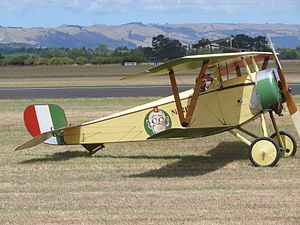 |
|
| Replica Nieuport 11 in Italian markings | |
| Role | Fighter |
|---|---|
| Manufacturer | Nieuport |
| Designer | Gustave Delage |
| Introduction | 5 January 1916 |
| Status | retired |
| Primary users | Aéronautique Militaire (France) Corpo Aeronautico Militare (Italy), Imperial Russian Air Service |
| Variants | Nieuport 16 |

The Nieuport 11 was a newer, much smaller aircraft based on the general configuration of the Nieuport 10, but designed specifically as a single-seat fighter. Like the "10", the "11" was a sesquiplane, a biplane with a full-sized top wing with two spars, and a lower wing of much narrower chord and a single spar. Interplane struts in the form of a "Vee" joined the upper and lower wings. The sesquiplane layout reduced drag and improved the rate of climb, as well as offering a better view from the cockpit than either biplane or monoplane, while being substantially stronger than contemporary monoplanes.


The Nieuport 11 reached the French front in January 1916, and 90 were in service within the month.
This small sesquiplane outclassed the Fokker Eindecker in every respect, including speed, climb rate and maneuverability. It featured ailerons for lateral control rather than the Fokker's wing warping, giving lighter, quicker roll response, and its elevator was attached to a conventional tail plane which provided better pitch control as opposed to the all-moving, balanced "Morane type" elevators of the Fokker.
Ceiling
MAX RANGE
Aircraft Speed
Max Crew


In 1916 an improved version appeared as the Nieuport 16, which was a strengthened Nieuport 11 airframe powered by a 110 hp (82 kW) Le Rhône 9J rotary engine.
Designed by Gustave Delage in 1914, the Nieuport 11 biplane was affectionately known as the "Bébé" (Baby).